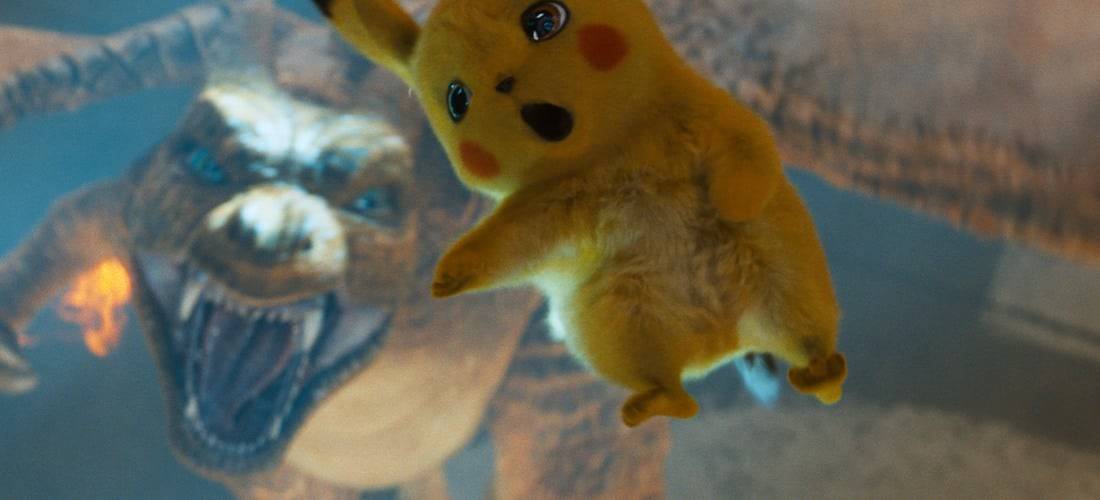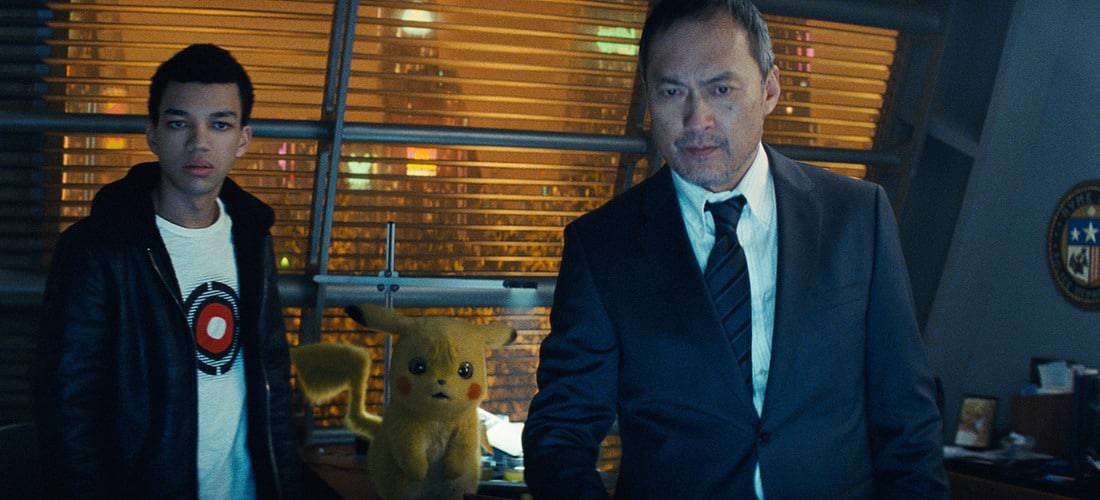The following is an in-depth review of Detective Pikachu, including plot details that some may consider to be spoilers. This is a very fluffy warning.
You go see a movie called Pokémon: Detective Pikachu to see Pokémon. Just as you go see a movie called Transformers to see Transformers. Toy and game franchises with a large catalog of characters can be difficult to adapt to a cohesive singular story because the fans want all their favorites to make the cut. I can recall being disappointed as a kid that, with nine series of trading cards amounting to hundreds of crude characters to choose from, only seven Garbage Pail Kids appear in The Garbage Pail Kids Movie (of course, that film has other issues). The first live-action Pokémon movie doesn’t fail its fandom when it comes to numbers of Pokémon — of the available 809 types of “pocket monsters,” Detective Pikachu features at least 50 species — but where there is quantity there is not necessarily quality.
The various Pokémon are adapted well visually, at least. Legendary Pictures clearly spared no expense when it comes to the quality of making these creatures, which are familiar to millions around the world through video games, animated series, trading cards, and more, look lifelike while still retaining a faithful cartoonish appearance for recognizability. Production designer Nigel Phelps (Transformers: Revenge of the Fallen) did the right thing in hiring R.J. Palmer to work on concept art for Detective Pikachu after finding the young illustrator’s “Realistic Pokémon” pieces online via Google search. Director Rob Letterman (Goosebumps) says they spent a year on the creature designs before shooting in order to get them right. Then visual effects teams were tasked with bringing Palmer’s concepts to life with photorealistic CGI while Letterman shot on film to give the movie an impression of practicality.
If only they’d spent as much time honing the script for Detective Pikachu. The result of the perfection that went into the creature design and world building is that Legendary and Nintendo and The Pokémon Company have established an impressive foundation from which to build a film franchise, but the storytelling in this first movie doesn’t match the vividness of its playground. Not that Legendary skimped when it came to that department. The production spent plenty on engaging at least eight known screenwriters for the Detective Pikachu screenplay. First, there were Nicole Perlman (Guardians of the Galaxy) and Alex Hirsch (Gravity Falls), and the former still has a story credit on the finished product. Then Eric Pearson (Thor: Ragnarok) and Oscar-winning Spotlight writer/director Tom McCarthy provided some uncredited polishing, and along the way, the final script was reworked by the team of Dan Hernandez and Benji Samit (The Tick) with enough input from Derek Connolly (Jurassic World) and Letterman for them to also earn official recognition.

That’s a lot of cooks in the kitchen, and most of them weren’t directly collaborating with each other. Even Ryan Reynolds, who voices the title character, got to have a hand in the material. “A whole bunch of us took passes at the script,” he told ComicBook.com. “I also took a pass at the script. We all got to kind of shape it the way we wanted; I got to make sure the voice sort of worked the way I think it could work for me.” He says he was ultimately at the mercy of the filmmakers. In the end, everything that wound up on the screen, including Reynolds’ motormouth dialogue, would, of course, come down to Letterman, his producers, and editors Mark Sanger and James Thomas. But it’s evident with this busy and often baffling movie that the filmmakers were juggling a lot of content and dealing with a multitude of requirements for the plot of Detective Pikachu.
Obviously, there must have been a desire to pack as many Pokémon as possible into it. Yet this particular movie centers around just one particular Pokémon, so the rest had to play minor roles. Many of them, including such favorites as Aipom, Charizard, Psyduck, Mr. Mime, Greninja, and the very powerful, genetically engineered Mewtwo, factor into the story in some way. The rest are set dressing, background players employed in the demonstration of how this world works while also serving the fans with plenty of Easter egg level cameos — can you catch sight of ’em all? the film asks of its audience. Some of these, such as Snorlax, Jigglypuff, and Squirtle, are more prominently displayed than others, essentially for quick visual gags. For anyone who isn’t a diehard devotee of all things Pokémon, the abundance of creatures in each shot can be as distracting as it is enriching.
Rather than being open and free to the potential of this authentic world of Pokémon — imagine what Phil Lord and Christopher Miller could do with this sandbox — the many screenwriters involved with Detective Pikachu were limited by the decision to translate the video game of the same name to the big screen. The adaptation retains most of the game’s story, in which a young man named Tim Goodman arrives in Rhyme City after learning his police detective father, Harry, has gone missing. Tim meets an amnesiac talking Pikachu, which only he can understand, and they team up to solve the case of what happened to Harry. The mystery involves a drug called “R” that causes Pokémon to become violent, and additional human characters include the employees of a news network and the scientists who created the drug out of Mewtwo DNA.
The movie takes some liberties in the details, whether these changes are to keep the plot more contained (some of the game’s narrative is left open at the end) or to introduce more action to a cinematic version of the premise (in the game, Pikachu has no powers, but here he does). Tim (played by Justice Smith) is a reluctant hero in the adaptation. He doesn’t really like Pokémon, let alone have one as a companion, and he was estranged from Harry, whom he’s told has died rather than disappeared. This doesn’t make him all that likable at first but does give him a relatable arc through which he must not only grow to befriend his Pikachu partner but also learn about and forgive and care about the absent father he hardly knew. This character evolution is played simply and sappily, appropriate for a PG audience, with a predictable turn of events that lead to an emotionally awkward payoff that younger viewers won’t appreciate anyway.
The rest of the human characters are altogether less fleshed out than any single computer-generated Pokémon. There’s Tim’s Pokémon trainer friend (Karan Soni) at the beginning, whose existence lasts for just the one scene. Next is the Rhyme City police chief (Ken Watanabe), who isn’t given much more than that to do, followed by news intern and love interest Lucy (Kathryn Newton), who despite having a lot to do, including pretty much figuring out the case on her own and saving Tim’s life, is never given any depth beyond being a news intern and love interest. She’s not even enough of the latter to mean anything to the story at the very end, however. There are two other women in the film, a mute assistant (Suki Waterhouse) who simply ushers other characters around in a few scenes and a scientist (Rita Ora), whose significance to the story is a bit of a blur.

There’s also Bill Nighy as Howard Clifford, the wealthy engineer behind Rhyme City — it was his vision to have humans and Pokémon living and working together in harmony — and his son (Chris Geere), a shady news network mogul named Roger, who is set up as the mastermind behind a convoluted conspiracy involving “R” and Mewtwo, which Harry had gotten mixed up while investigating the drug. The father/son dynamic here seems meant to parallel Tim and his father’s relationship, but there’s never any resonance to the idea. Mainly because these, like the rest of the characters, aren’t so much written as people as dots on a plot outline. Nobody in the movie has any purpose outside of their narrative link to Tim, but the vagueness of character depth for some of them, we eventually realize, is all to keep them malleable for all the red herring twists in the third act.
But who cares about the humans in a Pokémon movie, right? Considering most of the creatures in Detective Pikachu aren’t given much personality beyond their basic Pokémon traits, the blandness of the human characters helps to highlight these non-humans. Still, so many of the Pokémon are paired with humans — a symbiotic service-animal kind of relationship, only maybe it’s the humans who are the service animals to the volatile monsters in need — that few of them get to stand out on their own anyway. The closest thing to a Pokémon with a personality outside of the titular Pikachu is Lucy’s Psyduck, whose powers have been slightly altered for the film so that he can be employed as a weapon when needed. Throughout the movie, it’s warned that the Psyduck could explode if it gets too stressed, and that’s used for tension in a number of scenes. Of course, when the time comes for it to actually blow up, the Pokémon itself does not explode so much as emit a wave of energy that blasts everything except, conveniently, the heroes. Again, for all the strong foundation of this world, specifics atop that foundation are inconsistent.
Much of what does work in Detective Pikachu stems from an elementary desire to showcase a handful of Pokémon, and there are some fantastic setpieces as a result. Despite Rhyme City outlawing Pokémon battles, those are a central part of the brand, and so, of course, there’s an underground cage-match arena where we get to see Pikachu take on a drugged Charizard while Diplo DJs in the background. In another, truly beautiful moment, one that hints at what a live-action remake of a Miyazaki film might look like, the heroes are guided through nature by Bulbasaurs and the glowing, floating mushroom-like Morelulls. Yet the logistics of giving the fans these and other visual delights within the context of the plot are so loose that they feel remote from the story. We can assume they were conceived separately then needed to be jammed into the adapted plot, and vice versa.
Detective Pikachu doesn’t just suffer from a script that is at once shallow and predictable then overly complicated and twisty, the problem is that so little of the plot flows in a way that balances or smooths out these contrasting layers. Even the final scene, with its reveal that’s been telegraphed numerous times throughout the movie, seems tacked on. There’s no doubt the moment was planned all along, as Letterman says (spoiler), but it’s also another big idea that seems like it was created in a vacuum and then shoehorned into what the rest of the many writers contributed to the script. Such disjointed storytelling — that includes Pikachu’s rambling commentary, the mileage of which may vary depending on how much you enjoy nonstop PG-rated Reynolds witticisms that also, because most people can’t hear them in-story, are in a kind of vacuum — laid out over such a fascinating infrastructure is disorienting, and that’s incredibly disappointing.
But maybe the next movie set in this world — now that all the groundwork is established — can focus on a more cohesive and satisfying script with better-written human characters (if not also, somehow, more compelling Pokémon characters besides Pikachu) with motivations that we can comprehend and care about. Legendary already has a sequel in the works with a whole new screenwriter, Oren Uziel (22 Jump Street), on the case. Hopefully, he alone can crack it.
The post The Dazzling Mess of ‘Detective Pikachu’ appeared first on Film School Rejects.
0 comments:
Post a Comment